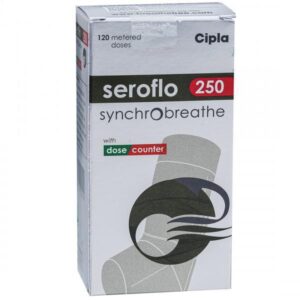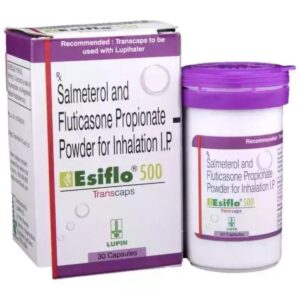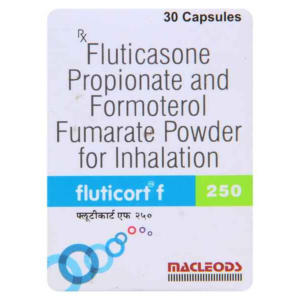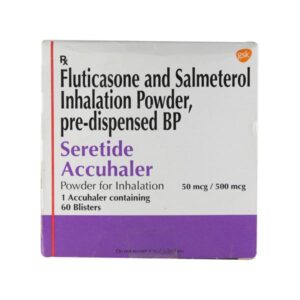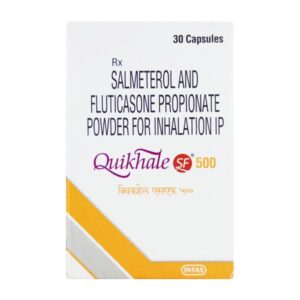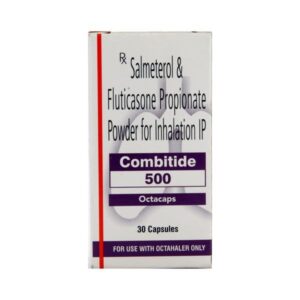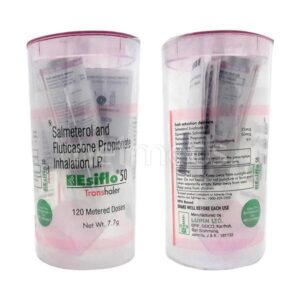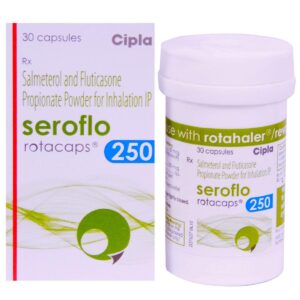SALMETEROL + FLUTICASONE
Salmeterol: Salmeterol is a medication primarily used in the management of asthma and chronic obstructive pulmonary disease (COPD). It belongs to the class of drugs known as long-acting beta2-adrenergic agonists (LABAs).
The main mechanism of action of Salmeterol is its ability to selectively stimulate the beta2 adrenergic receptors in the smooth muscles of the lungs. This stimulation leads to the relaxation of the bronchial smooth muscles, resulting in bronchodilation and improved airflow. Salmeterol has a long duration of action, which makes it effective for the prevention of bronchospasm and maintenance of stable breathing patterns.
Salmeterol is available as an inhalation powder or aerosol metered-dose inhaler. The usual recommended dose for adults and children over 12 years of age is 1 inhalation (50 mcg) twice daily, with at least 12 hours between doses. However, the specific dosage and frequency may vary depending on the individual’s condition and the severity of symptoms.
While Salmeterol is generally well-tolerated, it can have some potential side effects. The most common side effects include headache, tremor, palpitations, muscle cramps, and throat irritation. Rarely, some individuals may experience more serious side effects, such as chest pain, rapid heart rate, allergic reactions, or paradoxical bronchospasm (worsening of breathing difficulties). It is important to consult a healthcare professional if any of these side effects occur.
Salmeterol should not be used as a rescue medication during acute asthma or COPD exacerbations. Instead, it is typically prescribed as part of a long-term management plan in combination with an inhaled corticosteroid, which helps to control inflammation in the airways.
It is crucial to note that Salmeterol should not be used alone for the treatment of asthma, as it carries an increased risk of severe asthma-related complications and even death. Therefore, it should always be used in combination with an inhaled corticosteroid as prescribed by a healthcare professional.
Fluticasone: Fluticasone is a medication that belongs to the class of drugs known as corticosteroids. It is primarily used to manage symptoms of allergies, including nasal congestion, sneezing, itching, and runny nose. It is available as a nasal spray and is commonly sold under the brand name Flonase.
The mechanism of action of fluticasone involves reducing inflammation and suppressing the immune response in the nasal passages. It works by inhibiting the release of substances called cytokines, which are responsible for causing the symptoms of allergies. This helps to alleviate symptoms and improve nasal congestion.
The typical recommended dose of fluticasone nasal spray for adults and children 12 years and older is 2 sprays in each nostril once daily. It is important to follow the directions provided by the doctor or the directions on the product label. The dose may vary for children under 12, depending on their age and medical condition.
Like any medication, fluticasone may cause certain side effects. Common side effects include nasal irritation, nosebleeds, headache, sore throat, cough, and sneezing. These side effects are usually mild and go away on their own. In some cases, long-term use or high doses of fluticasone may be associated with more serious side effects, such as cataracts, glaucoma, reduced bone density, adrenal suppression, and slow growth in children. However, these side effects are rare and generally occur with prolonged use of high-dose corticosteroids.
It is important to consult a healthcare professional before starting fluticasone or any other medication to ensure proper use and understand the possible side effects.

